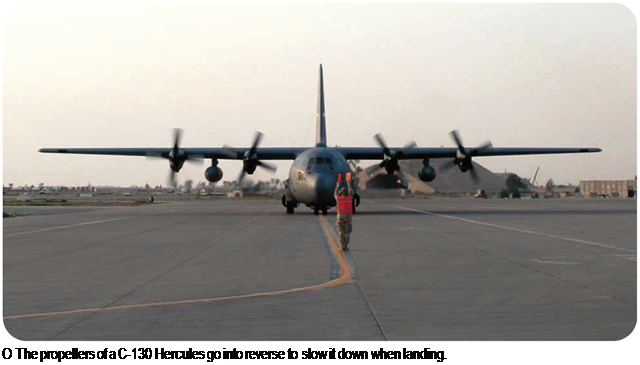Pusher Propellers
Modern propeller planes have their propellers at the front, pulling the plane through the air. These are called tractor
propellers. In the early days of aviation, it was just as common for planes to have their propellers at the back, pushing the aircraft. The first successful powered airplane, the Wright brothers’ Flyer, had two pusher propellers behind the wings.
Pusher propellers were popular because they did not get in the way of the air flowing over the wings. Without an engine or propeller in the way, the pilot had a great view ahead. It also was easier to fit guns in the nose of a fighter


PROPROTORS
The strangest propellers are called proprotors. They have this name because they work like helicopter rotors part of the time and like propellers the rest of the time. Compared to regular propellers, proprotors are enormous. The propellers of a C-130 Hercules cargo plane, for example, are 13.5 feet (4 meters) across. The V-22 Osprey’s proprotors are nearly three times as big: 38 feet (12 meters) across. When the Osprey is on the ground, its engines are tipped up, pointing straight up in the air. Its two propellers look like helicopter rotors, and they work in the same way-when they spin, they lift the Osprey straight up into the air. Then the engines swivel forward, and the rotors work like propellers.
C The Osprey’s engines and propellers tilt up (top left) for vertical takeoff. The engines tilt down and the propellers face forward (bottom left) for level flight.

plane that had its engine and propeller mounted in back.
Pusher propellers had drawbacks, however. They made it harder for pilots to escape from planes in the air without hitting a propeller. Also, the heavy weight of an engine at the back of a plane could be dangerous in a crash. It could move forward and crush the cockpit. The problem of fitting guns to fighter planes with propellers at the front was solved during World War I (1914-1918) by a device called an interrupter gear. It stopped a machine gun from firing when a propeller blade was in front of the gun barrel. The gun was synchronized to fire through the spaces between the blades. By the end of the war, nearly all fighter planes had their propellers at the front.










